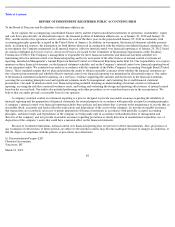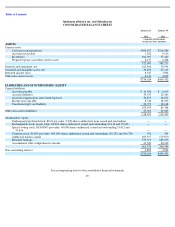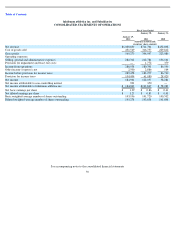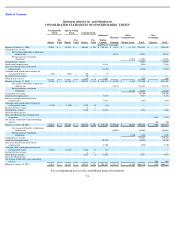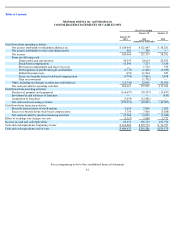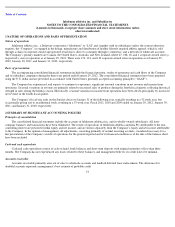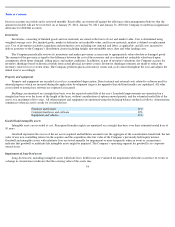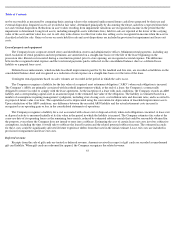Lululemon 2011 Annual Report Download - page 61
Download and view the complete annual report
Please find page 61 of the 2011 Lululemon annual report below. You can navigate through the pages in the report by either clicking on the pages listed below, or by using the keyword search tool below to find specific information within the annual report.
Table of Contents
operating costs are also denominated in Canadian dollars. The Company is also exposed to changes in interest rates. The Company does not
hedge foreign currency and interest rate exposure in a manner that would entirely eliminate the effect of changes in foreign currency exchange
rates, or interest rates on net income and cash flows.
The aggregate foreign exchange gains (losses) included in income amount to $(759), $477, and $174 for the years ended January 29,
2012, January 30, 2011, and January 31, 2010, respectively.
Concentration of credit risk
The Company is not exposed to significant credit risk on its cash and cash equivalents and trade accounts receivable. Cash and cash
equivalents are held with high quality financial institutions. Trade accounts receivable are primarily from certain franchisees and wholesale
accounts. The Company does not require collateral to support the trade accounts receivable; however, in certain circumstances, the Company
may require parties to provide payment for goods prior to delivery of the goods. The accounts receivable are net of an allowance for doubtful
accounts, which is established based on management’s assessment of the credit risks of the underlying accounts.
Stock
-based compensation
The Company accounts for stock-
based compensation using the fair value method. The fair value of awards granted is estimated at the date
of grant and recognized as employee compensation expense on a straight-line basis over the requisite service period with the offsetting credit to
additional paid-in capital. For awards with service and/or performance conditions, the total amount of compensation expense to be recognized is
based on the number of awards expected to vest and is adjusted to reflect those awards that do ultimately vest. For awards with performance
conditions, the Company recognizes the compensation expense if and when the Company concludes that it is probable that the performance
condition will be achieved. The Company reassesses the probability of achieving the performance condition at each reporting date. For awards
with market conditions, all compensation expense is recognized irrespective of whether such conditions are met.
Certain employees are entitled to share-based awards from the principal stockholder of the Company. These awards are accounted for by
the Company as employee compensation expense in accordance with the above-noted policies.
Earnings per share
Earnings per share is calculated using the weighted-average number of common shares outstanding during the period. Diluted earnings per
share is calculated by dividing net income available to common stockholders for the period by the diluted weighted-average number of common
shares outstanding during the period. Diluted earnings per share reflects the potential dilution from common shares issuable through stock
options and performance share units using the treasury stock method.
Use of estimates
The preparation of financial statements in conformity with generally accepted accounting principles in the United States requires
management to make estimates and assumptions that affect the reported amounts of assets and liabilities and the disclosure of contingent assets
and liabilities at the date of the financial statements as well as the reported amounts of revenue and expenses during the reporting period.
Recently issued accounting standards
In April 2010, the Financial Accounting Standards Board (“FASB”) amended Accounting Standards Codification (“ASC”) Topic 718
Compensation (“ASC 718”) to clarify that a share-
based payment award with an exercise price denominated in the currency of a market in which
a substantial portion of the entity’s equity
58


